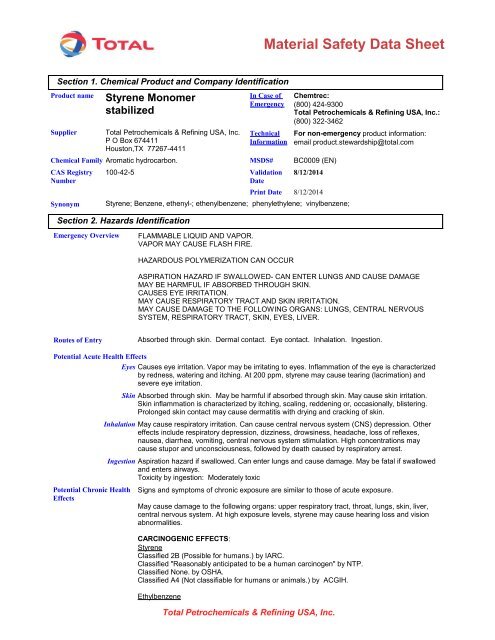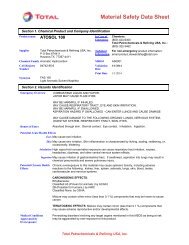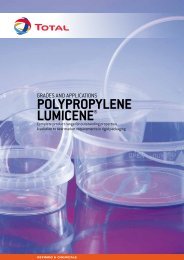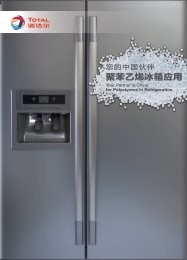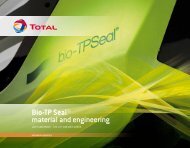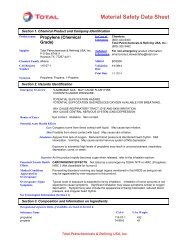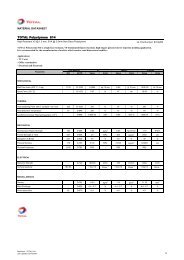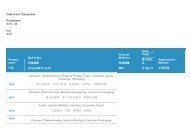6253 Styrene Monomer - Total Refining & Chemicals
6253 Styrene Monomer - Total Refining & Chemicals
6253 Styrene Monomer - Total Refining & Chemicals
You also want an ePaper? Increase the reach of your titles
YUMPU automatically turns print PDFs into web optimized ePapers that Google loves.
Material Safety Data Sheet<br />
Section 1. Chemical Product and Company Identification<br />
Product name<br />
Supplier<br />
Chemical Family Aromatic hydrocarbon.<br />
CAS Registry<br />
Number<br />
Synonym<br />
<strong>Styrene</strong> <strong>Monomer</strong><br />
stabilized<br />
<strong>Total</strong> Petrochemicals & <strong>Refining</strong> USA, Inc.<br />
P O Box 674411<br />
Houston,TX 77267-4411<br />
100-42-5<br />
In Case of<br />
Emergency<br />
Technical<br />
Information<br />
MSDS#<br />
Validation<br />
Date<br />
Print Date<br />
Chemtrec:<br />
(800) 424-9300<br />
<strong>Total</strong> Petrochemicals & <strong>Refining</strong> USA, Inc.:<br />
(800) 322-3462<br />
For non-emergency product information:<br />
email product.stewardship@total.com<br />
BC0009 (EN)<br />
8/12/2014<br />
8/12/2014<br />
<strong>Styrene</strong>; Benzene, ethenyl-; ethenylbenzene; phenylethylene; vinylbenzene;<br />
Section 2. Hazards Identification<br />
Emergency Overview<br />
FLAMMABLE LIQUID AND VAPOR.<br />
VAPOR MAY CAUSE FLASH FIRE.<br />
HAZARDOUS POLYMERIZATION CAN OCCUR<br />
ASPIRATION HAZARD IF SWALLOWED- CAN ENTER LUNGS AND CAUSE DAMAGE<br />
MAY BE HARMFUL IF ABSORBED THROUGH SKIN.<br />
CAUSES EYE IRRITATION.<br />
MAY CAUSE RESPIRATORY TRACT AND SKIN IRRITATION.<br />
MAY CAUSE DAMAGE TO THE FOLLOWING ORGANS: LUNGS, CENTRAL NERVOUS<br />
SYSTEM, RESPIRATORY TRACT, SKIN, EYES, LIVER.<br />
Routes of Entry<br />
Absorbed through skin. Dermal contact. Eye contact. Inhalation. Ingestion.<br />
Potential Acute Health Effects<br />
Eyes Causes eye irritation. Vapor may be irritating to eyes. Inflammation of the eye is characterized<br />
by redness, watering and itching. At 200 ppm, styrene may cause tearing (lacrimation) and<br />
severe eye irritation.<br />
Skin<br />
Inhalation<br />
Ingestion<br />
Absorbed through skin. May be harmful if absorbed through skin. May cause skin irritation.<br />
Skin inflammation is characterized by itching, scaling, reddening or, occasionally, blistering.<br />
Prolonged skin contact may cause dermatitis with drying and cracking of skin.<br />
May cause respiratory irritation. Can cause central nervous system (CNS) depression. Other<br />
effects include respiratory depression, dizziness, drowsiness, headache, loss of reflexes,<br />
nausea, diarrhea, vomiting, central nervous system stimulation. High concentrations may<br />
cause stupor and unconsciousness, followed by death caused by respiratory arrest.<br />
Aspiration hazard if swallowed. Can enter lungs and cause damage. May be fatal if swallowed<br />
and enters airways.<br />
Toxicity by ingestion: Moderately toxic<br />
Potential Chronic Health<br />
Effects<br />
Signs and symptoms of chronic exposure are similar to those of acute exposure.<br />
May cause damage to the following organs: upper respiratory tract, throat, lungs, skin, liver,<br />
central nervous system. At high exposure levels, styrene may cause hearing loss and vision<br />
abnormalities.<br />
CARCINOGENIC EFFECTS:<br />
<strong>Styrene</strong><br />
Classified 2B (Possible for humans.) by IARC.<br />
Classified "Reasonably anticipated to be a human carcinogen" by NTP.<br />
Classified None. by OSHA.<br />
Classified A4 (Not classifiable for humans or animals.) by ACGIH.<br />
Ethylbenzene<br />
<strong>Total</strong> Petrochemicals & <strong>Refining</strong> USA, Inc.
<strong>Styrene</strong> <strong>Monomer</strong><br />
stabilized<br />
_<br />
Classified 2B (Possible for humans.) by IARC<br />
See Section 11 for more detailed information on chronic effects.<br />
Page: 2/9<br />
Medical Conditions<br />
Aggravated by<br />
Overexposure<br />
Overexposure /Signs/<br />
Symptoms<br />
Pre-existing disorders involving any target organs mentioned in this MSDS as being at risk<br />
may be aggravated by over-exposure to this product.<br />
Skin: dermatitis<br />
Eye: conjunctivitis, burns<br />
CNS: respiratory depression, dizziness, drowsiness, headache, and loss of reflexes<br />
Other: decreased urination, , nausea, diarrhea, and vomiting<br />
See Toxicological Information (Section 11)<br />
Section 3. Composition and Information on Ingredients<br />
Occupational exposure limits, if available, are listed in Section 8.<br />
Substance Name<br />
CAS #<br />
% by Weight<br />
<strong>Styrene</strong> 100-42-5 > 99<br />
ethylbenzene 100-41-4
<strong>Styrene</strong> <strong>Monomer</strong><br />
stabilized<br />
Special Remarks on Fire<br />
Hazards<br />
Special Remarks on<br />
Explosion Hazards<br />
Page: 3/9<br />
_<br />
Flammable liquid. May autopolymerize if uninhibited, heated or involved in a fire.<br />
Autopolymerization will be accompanied by evolution of heat, which may cause release of<br />
styrene vapors forming flammable mixtures with air. Avoid heat, high temperatures, and static<br />
electricity.<br />
Vapors are heavier than air and may spread along floors. Vapor may travel a considerable<br />
distance to source of ignition and flash back.<br />
Not classified as an "Explosive" under the OSHA Hazard Communication Standard or by the<br />
DOT (see section 14 for DOT Hazardous Material Classification).<br />
Section 6. Accidental Release Measures<br />
Small Spill and Leak<br />
Large Spill and Leak<br />
Section 7. Handling and Storage<br />
Handling<br />
Storage<br />
Warn personnel to move away.<br />
Absorb with an inert material and put the spilled material in an appropriate waste disposal<br />
container.<br />
Contain spill and safely stop the flow.<br />
Warn personnel to move away.<br />
Eliminate all sources of ignition.<br />
Ventilate.<br />
Absorb with dry earth, sand or other non-combustible material.<br />
Prevent entry into sewers, basements or confined areas. Dike if necessary. Dike spill area<br />
and do not allow product to reach sewage system or surface or ground water.<br />
FLAMMABLE LIQUID AND VAPOR. Keep away from sources of ignition. Keep in a cool, wellventilated<br />
place. Manipulate in a well-ventilated area. Take precautionary measures against<br />
electrostatic discharges. Ensure that eyewash stations and safety showers are close to the<br />
workstation location.<br />
Do not store for extended periods. Avoid plastic, copper, and copper alloy containers.<br />
Hazardous auto-polymerization will be accompanied by evolution of heat, which may cause<br />
release of styrene vapors forming flammable mixtures with air and a potential fire. To<br />
prevent auto-polymerization of this material routinely monitor for percent polymer and<br />
inhibitor. Add inhibitor as needed. The most commonly used inhibitor is tertiary-butylcatechol<br />
in the 10-15 ppm concentration range. Higher concentrations may be needed.<br />
Inhibitor needs greater than 15 ppm dissolved OXYGEN (O2) to prevent polymerization.<br />
Do NOT blanket with nitrogen without providing means for keeping and checking a<br />
minimum of 15 ppm of oxygen (O2) dissolved in liquid phase. Inhibitor depletion and risk<br />
of polymerization will increase if product is stored under high temperatures, in the presence of<br />
moisture, rust, or other impurities, or for extended periods.<br />
Store below 84°F (29°C) in a dry, well-ventilated area. Storage temperature should to be<br />
continuously monitored. If the temperature rises 1°C/day, it may be an early indication of autopolymerization<br />
and the temperature should be monitored closely. Re-circulation of the<br />
material may stop or decrease the rate of temperature rise. A 2-3°C/day temperature<br />
increase is a typical indication of the onset of a runaway polymerization.<br />
When used properly, the inhibitor works effectively with styrene in the liquid state, but it does<br />
not prevent styrene polymerization in the vapor state. <strong>Styrene</strong> vapors may condense as<br />
solids, plugging pressure relief devices, causing overpressure/rupture of storage containers<br />
during runaway polymerization. Pressure relief devices must be checked and maintained on<br />
a frequent and regular basis to ensure polymer build up does not prevent the device from<br />
functioning properly.<br />
Take precautionary measures against static discharges.<br />
Ground all equipment containing material.<br />
Avoid all possible sources of ignition (spark or flame).<br />
Use materials for storage suitable for aromatic hydrocarbons for containers and transfer lines,<br />
such as stainless steel or carbon steel.<br />
Store away from and avoid contact with peroxides, oxidizing agents, acids and bases, copper<br />
<strong>Total</strong> Petrochemicals & <strong>Refining</strong> USA, Inc.
<strong>Styrene</strong> <strong>Monomer</strong><br />
stabilized<br />
and aluminium.<br />
_<br />
Page: 4/9<br />
Extremely reactive or incompatible with chlorosulfonic acid and sulfuric acid.<br />
All efforts should be made to prevent any leaks or spills. Storage tanks containing should be<br />
engineered to prevent contact with water resources, as this material could contaminate the<br />
water resources. Surface spills can reach groundwater through porous soil or cracked<br />
surfaces. The storage tanks should be monitored regularly for leaks. Where spills or leaks are<br />
possible, a comprehensive response plan should be developed and implemented.<br />
Section 8. Exposure Controls/Personal Protection<br />
Engineering Controls<br />
Personal Protection<br />
Protective Clothing<br />
(Pictograms)<br />
Provide exhaust ventilation or other engineering controls to keep the airborne concentrations<br />
of vapors below their respective threshold limit value. Ensure that eyewash stations and<br />
safety showers are proximal to the work-station location.<br />
Eyes Safety glasses with side shields. Splash goggles or face shield may be necessary if handling<br />
large amounts of material or heated material.<br />
Body Flame retardant clothing covering the entire body.<br />
Respiratory Vapor respirator. Be sure to use an approved/certified respirator or equivalent. Wear<br />
appropriate respirator when ventilation is inadequate.<br />
Hands Chemical-resistant gloves.<br />
Feet Shoes.<br />
Personal Protection in<br />
Case of a Large Spill<br />
Product Name<br />
Splash goggles. Full suit. Vapor respirator. Boots. Gloves. A self contained breathing<br />
apparatus should be used to avoid inhalation of the product. Suggested protective clothing<br />
might not be sufficient; consult a specialist BEFORE handling this product.<br />
Exposure Limits<br />
<strong>Styrene</strong> ACGIH TLV (United States, 3/2012).<br />
TWA: 20 ppm 8 hour(s).<br />
STEL: 40 ppm 15 minute(s).<br />
OSHA PEL Z2 (United States, 11/2006).<br />
TWA: 100 ppm 8 hour(s).<br />
CEIL: 200 ppm<br />
AMP: 600 ppm 5 minute(s).<br />
NIOSH REL (United States, 6/2009).<br />
TWA: 50 ppm 10 hour(s).<br />
STEL: 100 ppm 15 minute(s).<br />
ethylbenzene OSHA PEL (United States, 11/2006).<br />
TWA: 100 ppm 8 hour(s).<br />
NIOSH REL (United States, 6/2009).<br />
TWA: 100 ppm 10 hour(s).<br />
STEL: 125 ppm 15 minute(s).<br />
ACGIH TLV (United States, 3/2012).<br />
TWA: 20 ppm 8 hour(s).<br />
Consult local authorities for acceptable exposure limits.<br />
Section 9. Physical and Chemical Properties<br />
Physical State and Appearance<br />
Color<br />
Odor<br />
Odor Threshold<br />
Molecular Weight<br />
Molecular Formula<br />
Liquid.Clear<br />
Colorless.<br />
Aromatic.<br />
0.01-0.1 ppm<br />
104.14.<br />
C8-H8<br />
<strong>Total</strong> Petrochemicals & <strong>Refining</strong> USA, Inc.
<strong>Styrene</strong> <strong>Monomer</strong><br />
stabilized<br />
Boiling/Condensation Point<br />
145°C (293°F)<br />
_<br />
Page: 5/9<br />
Melting/Freezing Point<br />
Critical Temperature<br />
Specific Gravity<br />
Vapor Pressure<br />
Vapor Density<br />
Volatility<br />
Evaporation Rate<br />
VOC<br />
LogKow<br />
Ionicity (in Water)<br />
Solubility in Water<br />
May start to solidify at -31°C (-23.8°F) based on data for: <strong>Styrene</strong>.<br />
373°C (703.4°F)<br />
0.91 (Water = 1)<br />
4.3 mm of Hg (@ 20°C)<br />
3.6 (Air = 1)<br />
100% (v/v).<br />
0.49 compared to Butyl acetate.<br />
100 (%)<br />
The product is more soluble in oil; log(oil/water) = 3 <strong>Styrene</strong><br />
Non-ionic.<br />
Very slightly soluble in the following materials: hot water.<br />
The water solubility of styrene is 310 mg/L at 25°C.<br />
Section 10. Stability and Reactivity<br />
Stability and Reactivity<br />
Conditions of Instability<br />
Incompatibility with<br />
Various Substances<br />
Hazardous<br />
Decomposition Products<br />
Hazardous<br />
Polymerization<br />
Unstable.<br />
Unstable at high temperatures & extended storage.<br />
Extremely reactive or incompatible with chlorosulfonic acid and sulfuric acid.<br />
Avoid contact with peroxides, oxidizing agents, acids and bases, copper and aluminium.<br />
Carbon monoxide & carbon dioxide.<br />
Section 11. Toxicological Information<br />
Toxicity to Animals<br />
Chronic Effects on<br />
Humans<br />
HAZARDOUS POLYMERIZATION CAN OCCUR. The presence of copper or copper alloys<br />
may increase polymerization rate. Lack of inhibitor may also cause styrene to polymerize.<br />
Heat from spontaneous polymerization will be accompanied by evolution of heat, which<br />
may cause release of styrene vapors forming flammable mixtures with air and a<br />
potential fire.<br />
See Section 7: Handling and Storage for necessary measures to prevent spontaneous<br />
polymerization.<br />
Product/ingredient name Result Species Dose Exposure<br />
styrene LD50 Intraperitoneal Rat 898 mg/kg -<br />
LD50 Oral Rat 5000 mg/kg -<br />
LD50 Oral Rat 2650 mg/kg -<br />
LC50 Inhalation Vapor Rat 11800 mg/m3 4 hours<br />
LC50 Inhalation Gas. Rat 2770 ppm 4 hours<br />
ethylbenzene LD50 Dermal Rabbit >5000 mg/kg -<br />
LD50 Dermal Rabbit 17800 uL/kg -<br />
LD50 Oral Rat 3500 mg/kg -<br />
LC50 Inhalation Vapor Rat 55000 mg/m3 2 hours<br />
CARCINOGENIC EFFECTS:<br />
<strong>Styrene</strong><br />
Classified 2B (Possible for humans.) by IARC.<br />
Classified "Reasonably anticipated to be a human carcinogen" by NTP.<br />
Classified None. by OSHA.<br />
Classified A4 (Not classifiable for humans or animals.) by ACGIH.<br />
Ethylbenzene<br />
Classified 2B (Possible for humans.) by IARC<br />
<strong>Total</strong> Petrochemicals & <strong>Refining</strong> USA, Inc.
<strong>Styrene</strong> <strong>Monomer</strong><br />
stabilized<br />
_<br />
Page: 6/9<br />
The cancer causing potential of styrene has been studied extensively. Based on the current<br />
scientific evidence, regulators around the world have concluded that exposure to styrene does<br />
not increase the general population’s risk of cancer. Studies covering more than 55,000<br />
workers in the United States and Europe over a 45-year period in styrene-related industries<br />
collectively show that exposure to styrene in the workplace does not increase the risk of<br />
cancer, even when exposure to styrene is typically much higher than for the general<br />
population.<br />
There are studies that indicate a relationship between styrene exposure and an increase in<br />
lung tumors in mice. However, there are significant differences in how styrene is metabolized<br />
in mice and in humans. Because of these differences in the metabolism of styrene, these<br />
studies are not relevant to humans.<br />
TERATOGENIC EFFECTS:<br />
Comprehensive reviews of the developmental and reproductive data indicate that styrene is<br />
not teratogenic (i.e. causing birth defects), and provide little indication that styrene exposure<br />
could lead to any developmental or reproductive toxicity, including potential endocrine<br />
disrupter effects.<br />
There are reports of increases in embryonic, foetal, and neonatal death in rodents, but these<br />
effects are restricted to exposures were extremely high compare to expected human<br />
exposures and were maternally toxic. The bulk of current information suggests that styrene<br />
does not exert any specific developmental toxicities.<br />
The results of a definitive two-generation reproductive study and a developmental/<br />
neurotoxicity study, both in rats, show little evidence of any reproductive or developmental<br />
effect of concern.<br />
OTHER CHRONIC EFFECTS<br />
May cause: Hearing Loss at high exposure levels; Visual Alterations at high exposure levels.<br />
Other Toxic Effects on<br />
Humans<br />
Special Remarks on<br />
Toxicity to Animals<br />
Aspiration hazard if swallowed. Can enter lungs and cause damage. May be fatal if swallowed<br />
and enters airways. May cause skin, eye and respiratory irritation. Harmful if absorbed<br />
through the skin. May be harmful if absorbed through skin.<br />
May cause damage to the following organs: upper respiratory tract, throat., lungs, skin, liver,<br />
eye, lens or cornea., central nervous system.<br />
Standard Draize Test: Rabbit, Dose 100 mg, Eyes, Severe Reaction.<br />
Section 12. Ecological Information<br />
Ecotoxicity<br />
Product/ingredient name Result Species Exposure<br />
<strong>Styrene</strong> <strong>Monomer</strong> Acute EC50 4.7 mg/L Daphnia 48 hours<br />
Acute EC50 0.56 mg/L Algae 48 hours<br />
Acute LC50 29 mg/L Fish 96 hours<br />
Acute LC50 25.05 mg/L Fish 96 hours<br />
Acute LC50 10 mg/L Fish 96 hours<br />
Acute LC50 4.02 mg/L Fish 96 hours<br />
Biodegradable/OECD<br />
Volatizes rapidly and biodegrades in water. Biodegrades in soil.<br />
Mobility<br />
Based upon a vapor pressure of 4.3 mm of Hg (@ 20°C), styrene released to environmental<br />
is expect to volatize to the atmosphere.<br />
<strong>Styrene</strong> is expected to volatilize rapidly from water surfaces. A limited amount of styrene may<br />
remain in the water (the solubility of styrene in water is 0.310 g/L at 25°C).<br />
The Koc of styrene is estimated as 960. This estimated Koc value suggests that styrene is<br />
expected to have low mobility in soil.<br />
<strong>Total</strong> Petrochemicals & <strong>Refining</strong> USA, Inc.
<strong>Styrene</strong> <strong>Monomer</strong><br />
stabilized<br />
Section 13. Disposal Considerations<br />
_<br />
Page: 7/9<br />
Waste Information<br />
Recycle to process, if possible. Recover free liquid. Transfer to an approved disposal area in<br />
accordance with federal, state, and local regulations.<br />
Waste Stream<br />
Consult your local or regional authorities.<br />
This material, as supplied, when discarded or disposed of, is a hazardous waste according to<br />
Federal regulations (40 CFR 261) due to its ignitability. Soil, water, container residues and<br />
spill cleanup materials contaminated with this material may be classified as hazardous waste.<br />
Under RCRA, it is the responsibility of the user of the product to determine, at the time of<br />
disposal, whether the material is a hazardous waste.<br />
The transportation, storage, treatment and disposal of RCRA waste material must be<br />
conducted in compliance with 40 CFR 262, 263, 264. 268, and 270. Disposal can occur only<br />
in properly permitted facilities.<br />
Chemical additions, processing or otherwise altering this material may make the waste<br />
management information presented in the MSDS incomplete, inaccurate, or otherwise<br />
inappropriate.<br />
Classification: RCRA Harzardous Waste No. D001<br />
Section 14. Transport Information<br />
(for domestic bulk shipments, non-bulk shipments may differ)<br />
DOT Classification for<br />
Bulk Shipments (non bulk<br />
shipments may differ)<br />
Proper Shipping Name/<br />
Description<br />
UN Number<br />
Packing Group<br />
Marine Pollutant<br />
DOT CLASS 3: Flammable liquid.<br />
UN 2055, <strong>Styrene</strong> monomer, stabilized, 3, PG III RQ<br />
UN2055<br />
III<br />
Not listed in Appendix B to 49CFR172.101<br />
Hazardous Substances<br />
Reportable Quantity<br />
Special Provisions for<br />
Transport<br />
TDG Classification<br />
IMO/IMDG Classification<br />
ICAO/IATA Classification<br />
USCG Proper Shipping<br />
Name<br />
Transport in bulk<br />
according to Annex II of<br />
MARPOL 73/78 and the<br />
IBC Code<br />
<strong>Styrene</strong> 1000 lbs. (454 kg); Ethylbenzene 1000 lbs. (454 kg)<br />
See codes as shown in 49 CFR 172.101 column 7.<br />
TDG Class 3: Flammable liquid.<br />
3<br />
3<br />
<strong>Styrene</strong><br />
Product name: <strong>Styrene</strong> monomer (stabilized)<br />
Pollution category: Y<br />
Ship type: 2G<br />
Section 15. Regulatory Information<br />
HCS Classification<br />
U.S. Federal Regulations<br />
Flammable liquid<br />
Carcinogen<br />
Target organ effects<br />
TSCA 8(a) PAIR: Ethylbenzene<br />
United States inventory (TSCA 8b): All components are listed or exempted.<br />
<strong>Total</strong> Petrochemicals & <strong>Refining</strong> USA, Inc.
<strong>Styrene</strong> <strong>Monomer</strong><br />
stabilized<br />
International Regulations<br />
Clean Water Act (CWA) 307: ethylbenzene<br />
Clean Water Act (CWA) 311: <strong>Styrene</strong><br />
_<br />
Page: 8/9<br />
SARA 302/304/311/312 extremely hazardous substances: To the best of our knowledge,<br />
there are no substances that would be at reportable levels for this regulation in this product.<br />
SARA 302/304 emergency planning and notification: <strong>Styrene</strong><br />
SARA 302/304/311/312 hazardous chemicals: <strong>Styrene</strong><br />
SARA 311/312 MSDS distribution - chemical inventory - hazard identification: <strong>Styrene</strong>:<br />
Fire hazard, reactive, Immediate (acute) health hazard, Delayed (chronic) health hazard<br />
SARA 313 Supplier Notification<br />
This product contains the following EPCRA section 313 chemicals subject to the reporting<br />
requirements of section 313 of the Emergency Planning and Community Right-to-Know Act<br />
of 1986 (40 CFR 372 -Table 372.65).<br />
Product name CAS number Concentration (%)<br />
<strong>Styrene</strong> 100-42-5 >99<br />
ethylbenzene 100-41-4
<strong>Styrene</strong> <strong>Monomer</strong><br />
stabilized<br />
Page: 9/9<br />
_<br />
CALIFORNIA PROPOSITION 65: This product contains a chemical or chemicals known to<br />
the state of California to cause cancer, birth defects or other reproductive harm.<br />
Section 16. Other Information<br />
Label requirements<br />
FLAMMABLE LIQUID AND VAPOR.<br />
VAPOR MAY CAUSE FLASH FIRE.<br />
HAZARDOUS POLYMERIZATION CAN OCCUR<br />
ASPIRATION HAZARD IF SWALLOWED- CAN ENTER LUNGS AND CAUSE DAMAGE<br />
MAY BE HARMFUL IF ABSORBED THROUGH SKIN.<br />
CAUSES EYE IRRITATION.<br />
MAY CAUSE RESPIRATORY TRACT AND SKIN IRRITATION.<br />
MAY CAUSE DAMAGE TO THE FOLLOWING ORGANS: LUNGS, CENTRAL NERVOUS<br />
SYSTEM, RESPIRATORY TRACT, SKIN, EYES, LIVER.<br />
Hazardous Material<br />
Information System<br />
(U.S.A.)<br />
Health<br />
Fire Hazard<br />
Reactivity<br />
Personal Protection<br />
*<br />
2<br />
3<br />
2<br />
G<br />
National Fire<br />
Protection<br />
Association<br />
(U.S.A.)<br />
Health<br />
2<br />
3<br />
2<br />
Fire Hazard<br />
Reactivity<br />
Specific Hazard<br />
References<br />
Other Special<br />
Considerations<br />
Validated on 8/12/2014.<br />
EPA OPPT Chemical Fact Sheet EPA749F95019a<br />
HSDB - Hazardous Substances Data Bank<br />
RTECS - Registry of Toxic Effects of <strong>Chemicals</strong> Substances<br />
NIOSH Pocket Guide<br />
TOTAL PETROCHEMICALS (Europe) SDS<br />
ATSDR ToxProfiles 2008<br />
SAX, N.I. Dangerous Properties of Industrial Materials.<br />
For additional information on the safe use and handling of styrene, refer to the CEFIC <strong>Styrene</strong><br />
<strong>Monomer</strong>: Environmental, Health, Safety, Transport and Storage guidelines located on the Internet (<br />
http://www.cefic.org/Documents/IndustrySupport/Transport-and-Logistics/<strong>Styrene</strong>-<strong>Monomer</strong>-<br />
Environmental-health-Safety-and-Distribution-Guidelines.pdf).<br />
Printed 8/12/2014.<br />
Chemtrec:<br />
(800) 424-9300<br />
<strong>Total</strong> Petrochemicals & <strong>Refining</strong> USA, Inc.:<br />
(800) 322-3462<br />
Notice to Reader<br />
The information contained in this Material Safety Data Sheet (MSDS) / Safety Data Sheet (SDS) is believed by <strong>Total</strong> Petrochemicals & <strong>Refining</strong> USA, Inc. (TPRI)<br />
to be accurate on the date issued. However, materials may present unknown hazards and should be used with caution. Final determination of suitability and use<br />
of any material is the sole responsibility of the user. Neither TPRI nor any of its subsidiaries or affiliated companies assumes any liability whatsoever for the<br />
accuracy or completeness of the information contained herein or reliance thereto. If the material is repackaged, the user is responsible and must ensure that<br />
proper health, safety and other necessary information is included with the material and/or on the container. NO WARRANTIES OF ANY KIND, EITHER<br />
EXPRESSED OR IMPLIED, INCLUDING WARRANTIES OF MERCHANTABILITY OR FITNESS FOR A PARTICULAR PURPOSE, ARE MADE<br />
REGARDING THE MATERIALS OR THE INFORMATION CONTAINED IN THIS SDS. ALTERATION OF THIS DOCUMENT IS STRICTLY<br />
PROHIBITED.<br />
MSDS Name <strong>Styrene</strong> <strong>Monomer</strong> MSDS Code STYRENE_MONOMER<br />
34.01<br />
To obtain an electronic copy of this MSDS, please email: product.stewardship@total.com.<br />
<strong>Total</strong> Petrochemicals & <strong>Refining</strong> USA, Inc.


